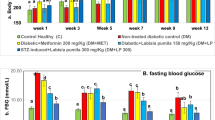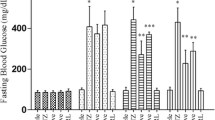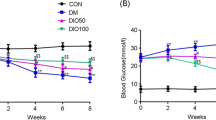Abstract
The aim of this study was designed to investigate the possible beneficial effects of Nigella sativa (NS) and thymoquinone (TQ) on histopathological changes of sciatic nerves in streptozotocin-induced diabetic rats. The rats were randomly allotted into one of four experimental groups: A (control), B (diabetic untreated), C (diabetic treated with NS) and D (diabetic treated with TQ); each group contain ten animals. B, C and D groups received streptozotocin (STZ) to induce diabetes. The rats in NS and TQ treated groups were given NS (in a dose of 400 mg/kg body weight) and TQ (50 mg/kg body weight) once a day orally by using intra-gastric intubation for 12 weeks starting 2 days after STZ injection, respectively. Blood and tissue samples were obtained for biochemical and histopathological investigation. The treatment of both NS and TQ caused a sharp decrease in the elevated serum glucose (P < 0.01, 0.05, respectively), and an increase in the lowered serum insulin concentrations (P < 0.01, 0.05, respectively), in STZ-induced diabetic rats. STZ induced a significant decrease in the area of insulin immunoreactive β-cells (P < 0.0001). NS (P < 0.001) and TQ (P < 0.01) treatment resulted in increased area of insulin immunoreactive β-cells significantly. To date, no histopathological changes of sciatic nerves in STZ induced diabetic rats by NS and TQ treatment have been reported. In this study, histologic evaluation of the tissues in diabetic animals treated with TQ and especially NS showed fewer morphologic alterations. Myelin breakdown decreased significantly after treatment with NS and TQ. The ultrastructural features of axons also showed remarkable improvement. We believe that further preclinical research into the utility of NS and TQ may indicate its usefulness as a potential treatment on peripheral neuropathy (PN) in STZ induced diabetic rats.



Similar content being viewed by others
References
Thorpe SR, Baynes JW (1996) Role of the Maillard reaction in diabetes mellitus and diseases of aging. Drugs Aging 9(2):69–77
Baynes JW (1991) Role of oxidative stress in development of complications in diabetes. Diabetes 40:405–412
Gillery P, Monboisse JC, Maquart FX, Borel JP (1989) Does oxygen free radical increased formation explain long term complications of diabetes mellitus? Med Hypotheses 29(1):47–50
Rakieten N, Rakieten ML, Nadkarni MV (1963) Studies on the diabetogenic action of streptozotocin. Cancer Chemother Rep 29:91–98
Bhattacharya G (1954) On the protection against alloxan diabetes by hexoses. Science 120:841–843
Schein PS, Cooney DA, McMenamin MG, Anderson T (1973) Streptozotocin diabetes—further studies on the mechanism of depression of nicotinamide adenine dinucleotide concentrations in mouse pancreatic islets and liver. Biochem Pharmacol 15:2625–2631
Matkovics B, Kotorman M, Varga IS, Hai DQ, Varga C (1997–1998) Oxidative stress in experimental diabetes induced by streptozotocin. Acta Physiol Hung 85:29–38
Jakobsen J, Lundbaek K (1976) Neuropathy in experimental diabetes: an animal model. Br Med J 2:278–279
Jakobsen J (1979) Early and preventable changes of peripheral nerve structure and function in insulin-deficient diabetic rats. J Neurol Neurosurg Psychiatry 42:509–518
Sharma AK, Thomas PK, De Molina AF (1977) Peripheral nerve fiber size in experimental diabetes. Diabetes 26:689–692
Sharma AK, Duguid IG, Blanchard DS, Thomas PK (1985) The effect of insulin treatment on myelinated nerve fiber maturation and integrity and on body growth in streptozotocin diabetic rats. J Neurol Sci 67:285–297
The Diabetes Control, Complications Trial Research Group (1995) The effect of intensive diabetes therapy on thedevelopment and progression of neuropathy in the Diabetes Control and Complications Trial. Ann Int Med 122:561–568
Cameron NE, Cotter MA, Basso M, Hohman TC (1997) Comparison of theeffects of inhibitors of aldose reductase and sorbitol dehydrogenase on neurovascular function, nerve conduction and tissue polyol pathway metabolites in streptozotocin-diabetic rats. Diabetologia 40:271–281
Karachalias N, Babaei-Jadidi R, Ahmed N, Thornalley PJ (2003) Accumulation of fructosyl-lysine and advanced glycation end products in the kidney, retina and peripheral nerve of streptozotocin-induced diabetic rats. Biochem Soc Trans 31:1423–425
Gries AF (1995) Alternative therapeutic principles in the prevention of microvascular and neuropathic complications. Diabetes Res Clin Pract 28(Suppl):S201–S207
Vague P, Coste TC, Jannot MF, Raccah D, Tsimaratos M (2004) C-Peptide Na+,K+-ATPase and diabetes. Exp Diabesity Res 5:37–50
Babaei-Jadidi R, Karachalias N, Ahmed N, Battah S, Thornalley PJ (2003) Prevention of incipient diabetic nephropathy by high-dose thiamine and benfotiamine. Diabetes 52:2110–2120
The St Thomas’ Diabetic Study Group (1986) Failure of improved glycaemic control to reverse diabetic autonomic neuropathy. Diabet Med 3:330–4
El-Tahir KE, Ashour MM, Al-Harbi MM (1993) The respiratory effects of the volatile oil of the black seed (Nigella sativa) in guinea-pigs: elucidation of the mechanism(s) of action. Gen Pharmacol 24:1115–1122
El-Kadi A, Kandil O (1987) The black seed (Nigella sativa) and immunity: its effect on human T cell subset. Fed Proc 46:1222
Hanafy MSM, Hatem ME (1991) Studies on the antimicrobial activity of Nigella sativa seed (black cumin). J Ethnopharmacol 34:275–278
Zaoui A, Cherrah Y, Lacaille-Dubois MA, Settaf A, Amarouch H, Hassar M (2000) Diuretic and hypotensive effects of Nigella sativa in the spontaneously hypertensive rat. Therapy 55:379–382
Kanter M, Meral I, Yener Z, Ozbek H, Demir H (2003) Partial regeneration/proliferation of the ß-cells in the islets of Langerhans by Nigella sativa L. in streptozocin-induced diabetic rats. Tohoku J Exp Med 20:213–219
Kanter M, Coskun O, Korkmaz A, Oter S (2004) Effects of Nigella sativa on oxidative stress and ß-Cell damage in streptozocin-induced diabetic rats. Anat Rec 279:685–691
Kanter M, Coskun O, Budancamanak M (2005) Hepatoprotective effects of Nigella sativa L and Urtica dioica L on lipid peroxidation, antioxidant enzyme systems and liver enzymes in carbon tetrachloride-treated rats. World J Gastroenterol 11(42):6684–6688
Kanter M, Demir H, Karakaya C, Ozbek H (2005) Gastroprotective activity of Nigella sativa L oil and its constituent, thymoquinone against acute alcohol-induced gastric mucosal injury in rats. World J Gastroenterol 11(42):6662–6666
Kanter M, Coskun O, Uysal H (2006) The antioxidative and antihistaminic effect of Nigella sativa and its major constituent, thymoquinone on ethanol-induced gastric mucosal damage. Arch Toxicol 80(4):217–224
Kanter M, Coskun O, Kalayci M, Buyukbas S, Cagavi F (2006) Neuroprotective effects of Nigella sativa on experimental spinal cord injury in rats. Hum Exp Toxicol 25(3):127–133
Mahfouz M, El-Dakhakhny M (1960) The isolation of a crystalline active principle from Nigella sativa L. seeds. J Pharm Sci UAR 1:1–19
Houghton PJ, Zarka R, Heras B, Hoult RS (1995) Fixed oil of Nigella sativa and derived thymoquinone inhibit eicosanoid generation in leucocytes and membrane lipid peroxidation. Planta Med 61:33–36
Badary OA, Nagi MN, Al-Shabanah OA, Al-Sawaf HA, Al-Sohaibani MO, Al-Bekairi AM (1997) Thymoquinone ameliorates the nephrotoxicity induced by cisplatin in rodents and potentiates its antitumor activity. Can J Physiol Pharmacol 75:1356–1361
Al-Gharably M, Badary OA, Nagi MN et al (1997) Protective effect of thymoquinone against carbon tetrachloride-induced hepatotoxicity in mice. Res Commun Pharmacol Toxicol 2:41–50
Budancamanak M, Kanter M, Demirel A, Ocakci A, Uysal H, Karakaya C (2006) Protective effects of thymoquinone and methotrexate on the renal injury in collagen-induced arthritis. Arch Toxicol 80(11):768–776
Fararh KM, Atoji Y, Shimizu Y, Takewaki T (2002) Isulinotropic properties of Nigella sativa oil in Streptozotocin plus Nicotinamide diabetic hamster. Res Vet Sci 73:279–282
Fararh KM, Shimizu Y, Shiina T, Nikami H, Ghanem MM, Takewaki T (2005) Thymoquinone reduces hepatic glucose production in diabetic hamsters. Res Vet Sci 79:219–223
Passey RB, Gillum RF, Fuller JB, Urry FM, Giles ML (1974) Evaluation and comparison of 10 glucose methods and the reference method recommended in the proposed product class standard. Clin Chem 1977 23:131–139
Hales CN, Randle PJ (1963) Immunoassay of insulin with insulin-antibody precipitate. Biochem J 88:137–146
Hsu SM, Raine L, Fanger H (1981) Use of avidin-biotin-peroxidase complex (ABC) in immunperoxidase techniques: a comparison between ABC and unlabeled antibody (PAP) procedures. J Histochem Cytochem 29:577–580
Cameron NE, Cotter MA, Archibald V, Dines KC, Maxfield EK (1994) Anti-oxidant and pro-oxidant effects on nerve conduction velocity, endoneurial blood flow and oxygen tension in non-diabetic and streptozotocin-diabetic rats. Diabetologia 37:449–459
Tuck RR, Schmelzer JD, Low PA (1984) Endoneurial blood flow and oxygen tension in the sciatic nerves of rats with experimental diabetic neuropathy. Brain 107:935–950
Cameron NE, Cotter MA, Maxfield EK (1993) Anti-oxidant treatment prevents the development of peripheral nerve dysfunction in streptozotocin-diabetic rats. Diabetologia 36:299–304
Cameron NE, Cotter MA, Horrobin DH, Tritschler HJ (1998) Effects of alphalipoic acid on neurovascular function in diabetic rats: interaction with essential fatty acids. Diabetologia 41:390–399
Stevens MJ, Feldman EL, Thomas TP, Greene DA (1997) The pathogenesis of diabetic neuropathy. In: Veves A, Conn PMC (eds) Clinical management of diabetic neuropathy. Totowa, NJ, Humana, pp 13–47
Luo Y, Umegaki H, Wang X, Abe R, Roth GS (1998) Dopamine induces apoptosis through an oxidation-involved SAPK/JNK activation pathway. J Biol Chem 273:3756–3764
Park DS, Morris EJ, Stefanis L, Troy CM, Shelanski ML, Geller HM, Greene LA (1998) Multiple pathways of neuronal death induced by DNA-damaging agents, NGF deprivation, and oxidative stress. J Neurosci 18:830–840
Horrobin DF (1988) The roles of essential fatty acids in the development of diabetic neuropathy and other complications of diabetes mellitus. Prostaglandins Leukot Essent Fatty Acids 31:181–197
Ward KK, Low PA, Schmelzer JD, Zochodne DW (1989) Prostacyclin and noradrenaline in peripheral nerve of chronic experimental diabetes in rats. Brain 112:197–208
Subbiah MTR, Deitemeyer D (1980) Altered synthesis of prostaglandins in platelet and aorta from spontaneously diabetic Wistar rats. Biochem Med 23:231–235
Faux SP, Howden PJ (1997) Possible role of lipid peroxidation in the induction of NF-kappaB and AP-1 in RFL-6 cells by crocidolite asbestos: evidence following protection by vitamin E. Environ Health Perspect 105(Suppl 5):1127–1130
Adderley SR, Fitzgerald DJ (1999) Oxidative damage of cardiomyocytes is limited by extracellular regulated kinases 1/2-mediated induction of cyclooxygenase-2. J Biol Chem 274:5038–5046
Schmedtje JF Jr, Ji YS, Liu WL, DuBois RN, Runge MS (1997) Hypoxia induces cyclooxygenase-2 via the NF-kappaB p65 transcription factor in human vascular endothelial cells. J Biol Chem 272:601–608
Kathleen AH (2006) Peripheral neuropathy: pathogenic mechanisms and alternative therapies. Altern Med Rev 11(4):294–329
Tomlinson DR, Stevens EJ, Diemel LT (1994) Aldose reductase inhibitors and their potential for the treatment of diabetic complications. Trends Pharmacol Sci 15:293–297
Hong C (2000) Electrophysiology detection for EMG, SCV, MCV and SEP on diabetic patients suffering peripheral neuropathy. Acta Acad Med Xuzhou 20:427–428
Cameron NE, Cotter MA, Hohman TC (1996) Interactions between essential fatty acid, prostanoid, polyol pathway and nitric oxide metabolism in the neurovascular deficit of diabetic rats. Diabetologia 39:172–182
Yu JX, Yin XX, Shen JP, Qiu J, Yin HL, Jiang SJ (2006) Protective effects of bendazac lysine on diabetic peripheral neuropathy in streptozotocin-induced diabetic rats. Clin Exp Pharmacol Physiol 33:1231–1238
Sanchez-Ramirez GM, Caram-Salas NL, Rocha-Gonzalex HI, Vidal-Cantu GC, Medina-Santillan R, Reyes-Garcia G, Granados-Soto V (2006) Benfotiamine relieves inflammatory and neuropathic pain in rats. Eur J Pharmacol 530:48–53
Stracke H, Hammes HP, Werkmann D, Mavrakis K, Bitsch I, Netzel M, Geyer J, Kopcke W, Sauerland C, Bretzel RG, Federlin KF (2001) Efficacy of benfotiamine versus thiamine on function and glycation products of peripheral nerves in diabetic rats. Exp Clin Endocrinol Diabetes 109:330–336
Yagihashi S, Tokui A, Kashiwamura H, Takagi S, Imamura K (1982) In vivo effect of methylcobalamin on the peripheral nerve structure in streptozotocin diabetic rats. Horm Metab Res 14:10–13
Jain SK, Lim G (2001) Pyridoxine and pyridoxamine inhibits superoxide radicals and prevents lipid peroxidation, protein glycosylation, and (Na+ + K+)-ATPase activity reduction in high glucosetreated human erythrocytes. Free Radic Biol Med 30:232–237
Leahy J, Bonner-Weir S, Weir G (1992) Beta-cell dysfunction induced by chronic hyperglycemia: current ideas on mechanism of impairedglucose-induced insulin secretion. Diabetes Care 15:442–455
Rossetti L, Giaccari A, Defronzo R (1990) Glucose toxicity. Diabetes Care 13:610–630
Ar‘Rajab A, Ahrtn B (1993) Long-term diabetogenic effect of streptozotocin in rats. Pancreas 8:50–57
Wong KK, Tzeng ESF (1993) Appearance of different diabetic symptoms after streptotozocin administration: a comparison study. Biochem Mol Biol Int 30:1035–1041
Mattila PT, Knuuttila ML, Svanberg MJ (1998) Dietary xylitol supplementation prevents osteoporotic changes in streptozotocin-diabetic rats. Metabolism 47:578–583
Author information
Authors and Affiliations
Corresponding author
Rights and permissions
About this article
Cite this article
Kanter, M. Effects of Nigella sativa and its Major Constituent, Thymoquinone on Sciatic Nerves in Experimental Diabetic Neuropathy. Neurochem Res 33, 87–96 (2008). https://doi.org/10.1007/s11064-007-9419-5
Received:
Accepted:
Published:
Issue Date:
DOI: https://doi.org/10.1007/s11064-007-9419-5




